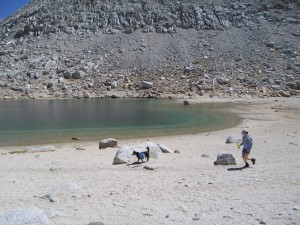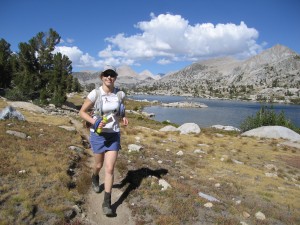I’m pleased to publish this guest article by Karen Schwartz, whom I met in the Eastern Sierra in late 2010. She and her husband Howie own Sage to Summit, a great mountain running and fastpacking store located in Bishop, California. They live in a geodesic dome in nearby Big Pine with their son Cosmo and dog Wheeler. Karen’s advice below is useful for anyone planning a challenging mountain run or hike. For more specific advice on where to run around Karen’s home town, check out this earlier post, “Running the Eastern Sierra Near Bishop and Mammoth,” and please support Sage to Summit by shopping for your gear through the links below.
Mountain running and fastpacking in the High Sierra are some of my favorite ways to spend time. I used to do a lot of both and could pull off huge single- and multiday adventures without any focused training because I was getting out all the time. I spent the last two summers preoccupied by being pregnant and a new mom, which significantly cut into my mountain running time. This summer, I plan to do a few of my favorite adventures, and since I don’t get out all the time anymore, I must prepare.
Running 20 to 40 miles a day in the mountains or doing 60 miles in two days is a big deal. Mentally, you have to be ready because you can’t drop out. It’s common on big days to ascend and descend 10,000 feet, so your muscles and joints must be prepared for the huge descents. A training run that incorporates going up and down a pass is the perfect way to prepare for the multi-pass day. Doing smaller training runs in the mountains is the only way to get dialed.
Your footwear and sock combination have to be perfect, too. Training runs will quickly point out potential flaws in your footwear systems so that on the big adventure, your feet won’t create unwanted surprises; however, duct tape or blister pads are great items to carry in case those sneaky hotspots appear.
My plan is to run in the mountains between 60 to 90 minutes one or two times a week and do three- to five-hour mountain runs two to three times a month. I’ll combine that with Crossfit and hour-long runs from my house. Combining all of those workouts, I’ll be exercising about four times a week. My training schedule is not rigid. My goal is to have a great time running long distances in the mountains. I am not too focused on time, other than not getting caught in the dark and factoring in a margin for error like getting lost or hurt.
It’s essential to carry equipment to stay fueled and hydrated, and to cope with unexpected situations and true emergencies. The lighter, the better. On a day trip, I carry a light pack and two hand-held water bottles. Typically, I take the bladder out of the daypack and use the storage space for my food, shell, gloves, buff, bandana, sunscreen, headlamp, anti-chafe lube and first aid kit. Each piece of equipment I carry has a distinct purpose.
Pack: I use the Nathan Intensity. The size and shape is perfect for my frame. Sage to Summit just brought in a new brand, UltrAspire, and I want to try out their running packs this summer.
Hand Bottles: These are a personal preference, something every mountain runner should own. However, some people like having a bladder on their back so they can be hands-free. I use the Nathan Quickdraw Plus. Depending on how much water you will encounter determines the size of your bladder and/or hand bottles.
Water Purification: SteriPens are cool (you don’t want it to break). Potable Aqua works too.
Shell: The lighter the better. Everyone at Sage to Summit uses the Magic Jacket and Magic Pants by CAMP USA. If there is stormy weather in the forecast, CAMP makes the B-Dry waterproof jacket that weighs under 3oz.
Hand protection: Lightweight gloves work. CAMP USA makes the Windmit’N which is the best lightweight mountain running hand protection on the market.
Headwear: Original Buff makes best piece of headwear on the market for summer days in the Sierra. It can be a hat and/or neck gaiter plus serve as sun protection.
Bandana: It is an essential piece for me; however, an optional piece for most. My face gets salty and nose gets runny. Also, it feels so good to wipe the face with a piece of cotton.
Headlamp: Essential. Long days start before the sun is up and typically end after the sun is down. (Note from Sarah: My personal preference is the Black Diamond Spot Headlamp.)
Anti-Chafe Lube: I use Body Glide.
Sun Protection: I do a huge lather session before leaving the house. I bring a sun stick with me.
First Aid: Ibuprofen, duct tape and a few blister pads, that’s all you need.
Nutrition: I bring real food—anything from a peanut butter & jelly sandwich to homemade cookies or bars. I supplement that with gels and energy bars. I’m a fan of chocolate Hammer gel and Pro Bars, any flavor. I don’t have stomach issues, but many people do. Nutrition is a key component to the day, because bonking or an upset stomach can truly inhibit how far you make it. It’s the training runs that help you figure out what works for your body. Ideally, you want to eat nutritious food with lots of calories that don’t weigh too much.
Items I wear:
Hat: Personally, I like Outdoor Research. I have a big noggin and they fit my head.
Shirt: Make sure it fits properly. Long runs make you salty and salt makes you chafe. Find a shirt that minimizes chafing. Training runs will sort this out. I like the ASICS Favorite Tees.
Shorts: Same chafing issues with shorts. Find shorts that minimize the chafe. I use the Brooks Glycerin Short.
Gaiters: Not essential, but nice to keep the socks clean. We sell Running Funky, Outdoor Research and CAMP USA gaiters.
Bra: Again, some bras chafe. All women need varying amounts of support. If your bra has had a birthday, get fitted for a new one.
Shoes: Get fitted for some. I wear the Brooks Cascadia, but am psyched to give the Brooks Pure Grit and the Salomon XR Mission a try.
Socks: Figure out what socks work for you. Good socks help prevent blisters. The right sock is just as important as the right shoe. If you’re blister prone, there are many fiber combinations on the market to wear test. Anything from 100% natural fiber blends, natural and synthetic blends, and 100% synthetic blends. Find the brand and model that prevents blisters for you. I use the Balega Trail Buster, a blend of synthetic fibers.
Multi Day Fastpacking Gear:
A 10 – 15L Pack: It’s nice to find one that works for running. Packs this size are typically built for hiking or mountain climbing. Find one that is comfortable but not too heavy. We just brought in the UltrAspire Fastpack.
Down Bag or Blanket: Down is lighter than synthetic and the precipitation in the Sierra is minimal so you don’t have to be too concerned with the down getting wet.
Ultralight Pad: We sell Klymit pads. The Inertia X-Lite is our staff pick.
Tarp or Bivy Sack: We sell Hyperlite Mountain Gear tarps. They are made of cuben fiber, which currently is one of the lightest materials on the market.
Stove/Pot: Titanium Triad alcohol stove, Wetfire solid fuel stove or if you’re melting snow or in a windy environment the Jetboil Sol is sweet.
Lightweight Meals: Mountain House Pro Pack is your best bet. They offer the most nutrition for the weight.
The goal on both multi- and single-day trips is to maximize comfort and safety while minimizing weight when choosing what gear to bring. If one piece of gear is a little heavier than other options, it might be the wise choice if it substantially increases your comfort and safety. On the flip side, if your gear is too heavy or you have too much, your comfort and safety will decrease because you’re no longer light and you won’t be moving fast.
Some of my favorites mountain runs and fastpacks in the High Sierra are:
- Start South Lake – Cloudripper – End Big Pine Creek
- Start South Lake – Herd Peak – Treasure Lakes – End South Lake
- Start Tuoulmne Meadows – End Yosemite Valley
- Start Pine Creek – Up Mt. Tom – End Horton Lake (my husband’s done this one)
Multi-Day:
- South Fork Big Pine Creek – Scimitar Pass – Camp – Up Sill – Potluck Pass – Thunderbolt Pass – Bishop Pass – End South Lake.
- Start Rock Creek – Mono Pass – Sleep at Vermilion Valley Resort – Selden Pass – Lodge – Muir Trail Ranch – Bishop Pass. This particular fastpack is great because you only have to carry a light day pack. Vermilion Valley Resort and Muir Trail Ranch have food and beds!
Thanks, Karen, for all the info and tips! For details on these and other routes, check out Sage to Summit’s comprehensive Sierra running guide. For more safety tips, see my earlier post, “How to Run and Hike Safely: Essential Gear and Precautions That Could Save Your Life.”



Karen,
I, too, have found duct tape to be awesome for blisters. But I haven’t come up with a method for having it pre-cut and portable. Have you experimented with this at all and with any degree of success? I have a few target areas that I pre-tape and would like to have some back-up already cut pieces along for the run, so that I don’t have to carry a giant roll and scissors.
Thanks in advance,
Marilyn
Marilyn,
I wrap duct tap around a small ballpoint pen or pencil, or trekking poles, if I am using them. I found good quality duct tape can rip between your fingers and you don’t have to carry scissors. It did take some trial and error in perfecting my technique on ripping the tape without scissors, but once you get the hang of it, it’s simple.
Marilyn and Karen, I found a useful article on the Badwater site about blister prevention, http://www.badwater.com/training/blisters.html
It says duct tape doesn’t work for everyone and it recommends tape such as Elastikon and Kinesiotape (sp?) instead.
Great information, thanks. Will be doing North Lake to South Lake in late July in one push and I hope to be able to stop by your store in Bishop while I’m in town.